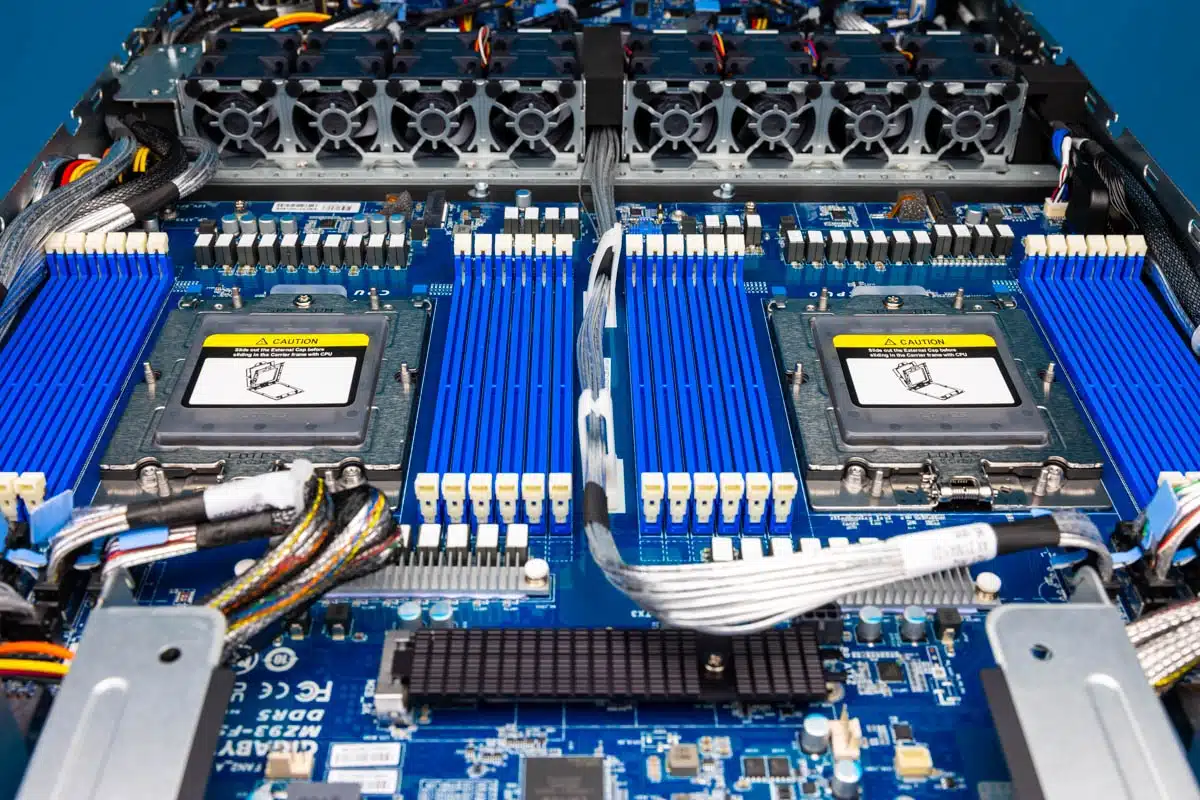The Gigabyte R183-Z95 is an impressive 1U server. It is built with two AMD EPYC 9004 series processors, yet that’s just the beginning. The server provides space for four different types of storage that can be directly fitted into the system without the need for HBAs or RAID controllers. This review will specifically delve into the unique E1.S EDSFF SSD bays. So, let’s start!
Gigabyte R183-Z95 External Overview
This server, found within a 1U system, extends 815mm or slightly over 32 inches deep. A first glance from the front reflects an element of uniqueness in its design.
Incorporating a USB 3 Type-A port, along with status LEDs and power buttons, the left side (excluding the left rack ear) presents a rarely seen design as front panel space is usually limited.
Adjacent to that is an array of eight 2.5″ drive bays. The maximum density is usually twelve 2.5″ front drive bays. However, this setup causes a cooling problem for the entire system and the drive trays often aren’t very robust. Gigabyte is offering ample storage here, using larger trays and more space for improved airflow.
The key to achieving 14x front panel drives lies in using EDSFF, or more precisely six E1.S drive bays.
You might have come across our EDSFF overview.
We had that overview in the initial stages of EDSFF. Currently, we have numerous drive manufacturers and systems that accept varying formats. Since we owned two systems on which we needed the drives, when I was in California for the recent Inside the Secret Data Center at the Heart of the San Francisco 49ers Levis Stadium story, I dropped by Kioxia and borrowed a few drives to use here.
We possess both Kioxia XD6 and Kioxia XD7P drives at our disposal.
An interesting aspect of EDSFF is the decision by server-makers, or allegedly reputed OEMs. They chose not to incorporate a latching mechanism in the specification, opting instead for unique drive carriers similar to those for 2.5? drives. Hence, servers must be accompanied by a small latching carrier to accommodate a server. This tiny carrier, fastened by two screws, represents one of the most bewildering aspects of today’s servers.
Fortunately, Gigabyte provides blanks, simplifying the process of installing latches on drives.
Another crucial factor is the size. This server is explicitly designed for E1.S 9.5mm drives (and smaller.) If you own a more substantial 15mm E1.S drive, equipped with a heatsink for thermal management, you’re minimally losing out on employing a complete six drive bays.
Utilizing 9.5mm drives allows us to include six E1.S drives in addition to the eight 2.5? NVMe SSDs, resulting in a total of fourteen drives on the front plate of the chassis.
Below is a concise comparison of the XD7P in 9.5mm and 15mm, providing a simple way to differentiate.
Let’s move to the server’s backside, where we encounter a widely accepted layout designed for individuals who want to operate A+B sides of racks for both power and networking.
Located on both sides are LiteOn 1.6kW power units. The placement of power supplies on each side enables a PDU connection on either side for A+B redundant power.
Either side of the rear features risers. These full-height risers use PCIe Gen5 x16 and require just a single thumbscrew for removal, making them straightforward to work with due to their cabling.
Located below these risers are OCP NIC 3.0 slots.
These slots accommodate A+B networking on either side of the chassis. In terms of design, Gigabyte utilises the SFF with pull tab style which makes servicing much easier.
At the rear, a divergence from the norm can be observed. Rather than VGA, a mini DisplayPort video output is available, accompanied by two standard USB 3 Type-A ports. Alongside this, there are three NICs, among which two are of the Intel i350-AM2 variety. This offers a better quality 1GbE NIC than the i210 – a small but appreciated enhancement.
We also get the out-of-band management port. The NIC and the ASPEED BMC are both on an OCP NIC 3.0 form factor card in the middle slot.
Next, let us get inside the system to see how it works.
ColoCrossing excels in providing enterprise Colocation Services, Dedicated Servers, VPS, and a variety of Managed Solutions, operating from 8 data center locations nationwide. We cater to the diverse needs of businesses of any size, offering tailored solutions for your unique requirements. With our unwavering commitment to reliability, security, and performance, we ensure a seamless hosting experience.
For Inquiries or to receive a personalized quote, please reach out to us through our contact form here or email us at sales@colocrossing.com.

